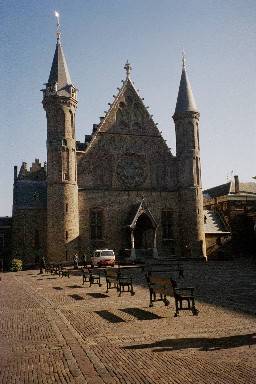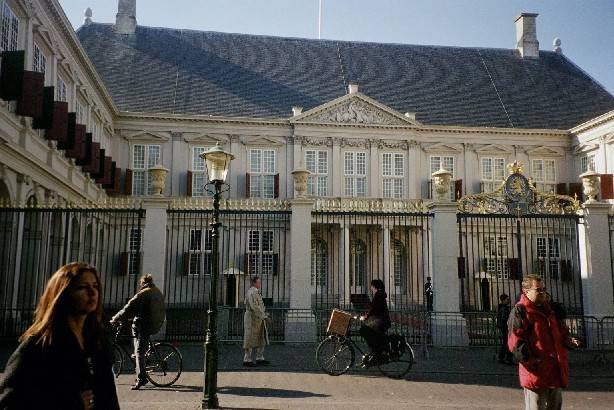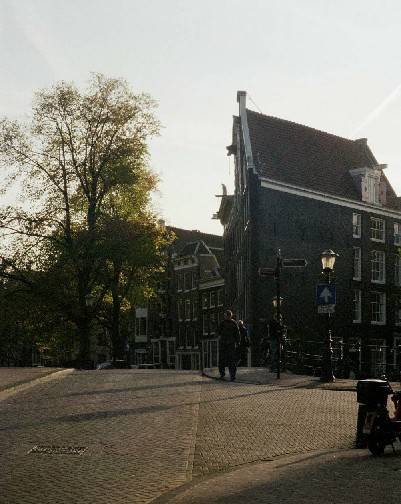The Netherlands (Holland) - a homogenous country with contrasts
Impressions of Almere, den Haag (the Hague), and Amsterdam
(best viewed in 800x600, normal/middle fonts)
Ijselmeer
Almerestadt
In October 2002 I visited the Netherlands with a colleague and a group of students from Aalborghus Gymnasium. Our stay was arranged by the municipal offices of the two sister cities of Aalborg and Almere, the latter a new city, planned and built on the newly reclaimed polder of Flevoland, situated east of Amsterdam to serve as a relief for the old and condemnable quarters of the capital and at the same time make room for a planned expansion of the quickly growing city (in the 1900s the number of inhabitants in the Netherlands tripled from 5 to 15 million, mostly immigrants from the former colonies in Indonesia, Surinam and South Africa, of which most have settled in the greater Amsterdam area).The building of the city of Almere started in the late 1960s; today the number of inhabitants has already grown to 165,000 and it is planned to house 375,000 people (which total will probably be reached within the next decade).
Planning and building a new city from scratch must be an architect’s idea of paradise, not only as far as the buildings themselves are concerned, but also the infrastructure: streets, traffic and public transport, shops. One big city or many smaller centers? One uniform look or (planned) diversity? etc.
The overall plan decided upon was a number of independent townships, each with its own town center and shops (not malls). As an immediate result of this, they differ in character and offer different features to the residence seeking public: a town-like environment or a harbor. Or a rural environment with next-door fishing opportunities in creeks.
This plan is much to be preferred to the uniform concrete residential high rises of the 1960s that offend the eye in the outskirts of most European cities, or the huge areas of detached houses one finds in more affluent neighborhoods outside a major city. In that respect Almere City is a huge success.
But – and there’s bound to be a ‘but’ since you can’t have everything – although Almere is a modern paradise in which everything is working according to plan, this fact is exactly what constitutes its most important drawback: the lack of atmosphere that springs from a place with no history. The many modern (almost futuristic) designs clearly signal the ‘60s prevailing moods and ideas of the future, but modern housing including broad streets also give room to emptiness or lack of atmosphere, a situation similar to the one found in the newly built center of the unified city of Berlin. Impressive architecture and careful city planning alone does not make it.
And that is Almere’s problem as history and age cannot be built. Therefore – since this must have been a well-known fact to the builders, it is not a miscalculation, but a fact that cannot be dealt with in any other way but to wait until the trees grow to their full size. On the other hand – could it be that the mental attitude of the spectator is what makes the difference? Do the young people of today miss history as much as I did?
(pictures to be supplied later)
The Hague


The Hague - the medieval parliament The Hague - the Queen's Castle
Quite the opposite mood is felt in the country’s governmental city of den Haag: here there is an abundance of old and historic mansions, many of which house embassies. Den Haag is a very elegant city (with elegant inhabitants), complete with a medieval castle (now parliament) including a knight’s hall (or baronial hall) and a nearby dungeon; the royal residence; and the International Courts of Justice such as the “Tribunal for War Criminals”. The shops and restaurants stock and serve their customers accordingly, and in the long run den Haag may actually be too much of an elegant city to offer the average resident the full variety and opportunity of a major city. After a few decades of a rather shabby existence, the nearby seaside resort of Scheveningen is now back in stride with many modern hotels facing the broad, sandy beaches.
 During our stay preparations were made to bury the recently deceased
Prince Claus,
During our stay preparations were made to bury the recently deceased
Prince Claus,and naturally the press (left) was there waiting for the funeral procession -
we didn't - (have the time).
Unfortunately, many of the streets in the city were blocked off
(to make passage for the procession)
as was the parliament castle itself (below),
mainly for security reasons.

 The Hague - Parliament
Lake (left)
The Hague - Parliament
Lake (left)
The (original) International Courts of Justice.
The churchlike building was erected in the late 1890s with the financial help of Carnegie who donated a million pounds to the cause: peaceful negotiations before wars.
Two World Wars later this wish was still unfulfilled, but in 1948 the International Courts of Justice finally came into its present being as an arbitrator between states.
Amsterdam
On this background, Amsterdam is a relief. Busy and bustling, and calm and quiet at the same time. The city’s medieval history is seen in every other street, canal, or house, but new houses in between make an interesting and varied blend. The traffic is terrible, especially the many daredevil bicyclists who scoot (shoot, rather) up behind you, left and right, and without warning. However, once you get away from the busy bridges and thoroughfares and turn down alongside the canals, you are safe – from traffic and the quick pace of modern life. The canal streets only allow one vehicle at a time in narrow one-way streets, and the neighboring waterfront helps soothe your spirits. In downtown Amsterdam, you are only a minute away from either the busy life of a capital, or the healing atmosphere of a houseboat.
Amsterdam - houseboats

The Dutch - a biking people



The church near Anne Frank's house - downtown Amsterdam is a web of canals - canal bridges are elevated to allow passage underneath
Thus Holland offers the traveler a lot of different impressions: from the quiet, rural marshlands - many of which are built on polders and framed by elaborate systems of dikes - to the spacious mansions of the returning overseas governors and diplomacy; to the mighty high rise towers of commerce, or to the old, narrow gables close together along the quays of the canals.
The overall impression of the Dutchmen is one of efficiency and practicalness (probably in part due to the country’s Calvinist cultural roots), but again there’s a mix of temperaments: the permissiveness toward mild drugs such as cannabis as well as otherwise illegal activities like prostitution is clearly seen. Cannabis users light up in the many “bruine kroegen” – small and dark cafés which contrast the modern glass and steel cafés so often found in major European cities including Amsterdam herself.
(It will be interesting to see if the Dutch approach to the problem of drugs is a wiser one; at least it seems to eliminate the crime of possessing smaller quantities of drugs and the resulting crimes related to the acquisition of the money needed to pursue one’s habit. The many alleged connections between the US police – who are supposed to fight drugs – and the drug suppliers point to the necessity of trying other ways and methods to combat drug abuse and especially the crimes related to it.)
Most of the people we met spoke excellent English, but like Danish, the Dutch language is much closer to German than English – in fact, we understood much of the Dutch dialogue spoken around us and often immediately understood many signs in window shops or advertisements – basically it seems to be a matter of knowing a great many synonyms in one’s own language.
Nearly all the Dutch people we talked to offered a voluntary statement about the introduction of the common European currency, the Euro (€) – prices have risen considerably, they said, but not our wages. Unlike in Denmark and Ireland, no referendum was taken before the introduction of the Euro, but all in all, being a nation of seafaring merchants and merchant farmers most Dutchmen are in favor of some sort of European Union, the question is only to what extent politically, economically, or militarily.
The 1500s’ Calvinist (Reformist) moral attitude that also eventually led to a rebellion against the Spanish (Catholic) rule is still reflected in ideals like prosperity through diligence (cp. the Puritan work ethic), but now mixed with the permissive attitude of the 1960s and after. The many coffee shops, in which the smoking of cannabis is allowed, are proof of the permissive attitude; and the Dutch tradition of not drawing the curtains (thus enabling everyone to look into the homes of people) is an example of "we’ve got nothing to hide" (which also happens to be exactly what the girls in the Red Light District (do not) do).
Somehow, it is more comforting to see a smiling and slightly red-eyed face leaving a coffee shop with a slight pitch than seeing boisterous or even bawling drunks leave the usual legal establishments of drink.
Erotic shop (below) and girls on display in windowed doors (right) are among the tourist attractions in Amsterdam but not really worth the lifting of an eyebrow - at least not to a fellow European from Scandinavia :


Life in the Dutch colonies – e.g. in Curacao, Guyana (now Surinam), Brazil, Angola, Mauritius, Ceylon (Sri Lanka), India, Indonesia (Java, Sumatra, New Guinea) and the Moluccas, China (Formosa), Tasmania, Spitsbergen and the Barents Sea (some of which are named after the Dutchman who ‘discovered’ them like Willem Barents, 1597, or Abel Tasman, 1642 ) – is well documented in the many museums of Amsterdam. In addition to the colonies the Dutch held many trading posts, for instance in Japan. In general, the Dutch settlers didn’t mix with the natives, but remained primarily traders. However, apparently the history of the Dutch Boers in South Africa is not a thing to be remembered as no reference to Afrikaner Nationalism was found in any of the colonial exhibits even if the well-known word of apartheid is Dutch.
South Africa is usually thought of as a British colony with strong ties to the UK, but equally strong ties have existed between the original Dutch settlers (the Afrikaans) and their motherland (the Dutch settlers constituting the majority of whites also after the British took over power). By 1938, Afrikaner nationalism had established strong bonds with the Dutch Reformed (Calvinist) Church, which was strongly opposed to any mixing of the races. In 1948 the (Dutch Afrikaner) National Party won a convincing victory fought over the issue of the separation of the races and immediately implemented the policy of racial segregation known as apartheid, designed to ensure the political and social superiority of whites over nonwhites in South Africa. The apartheid system was dismantled in 1992.
Most people know that New York City was originally called Nieuw Amsterdam (New Amsterdam – like Brooklyn was originally Breukelen ), but few people know that when England acquired the city and called it New York, it was the result of a bargain in which Holland took over Surinam in South America.
The fact that Holland received half of her present inhabitants from the former colonies in the latter half of the 1900s is reflected in the streets, in the menus, and in the players on the Dutch national soccer team (with internationals like Gullitt, Kluivert, Rijkard, and Seedorff, but also Frank de Boer and Ronald de Boer).
The national color is oranje (orange), a concept that goes back to Willem III of Oranje who led an uprising against Spanish rule in 1581. Through arranged marriages the Netherlands had come under Spanish rule in 1553 (the house of Habsburg), but independence was obtained in 1648. The political formation of the present kingdom dates from 1869.
(Incidentally, the Protestant Orange Order in Northern Ireland also reflects this link to Holland as the Protestant marchers identify with the Dutch, Protestant Prince William of Orange who was elected king of England, Scotland and Ireland in 1689 to prevent any returning to Catholic rule in the UK.)

When abroad with a group of students I always try to visit local schools to experience their learning environment. In Almere we visited a new vocational school with four-year courses in many different branches, e.g. carpentry, mechanics, engineering, EDP/ECP (computers), and home care/nursing.
Our students made a tour of the school with the Dutch students and chatted with them all the while, exchanging information on school life and such.
The Danes learned that in Dutch schools immigrants tend to stick together according to race, creed, or origin (the very three things that should not be discriminated against). Instead of classmates, you have schoolmates and seek your own kind. Not very promising prospects for an intercultural
future in a country that has a high percentage of immigrants.
A visit to a Dutch school- the Dutchman is the one in the middle
One particular house in Amsterdam was a must for my students: that of German immigrant Anne Frank whose family tried to escape Nazism by moving to Holland. Beautifully located in central Amsterdam in a canal street near a church, it offered a first hand experience of the backhouse apartment where she and her family and friends went into hiding for more than two years during World War II. Much to our disappointment the original furniture is not part of the exhibition, so it was a little difficult to eye-witness exactly how the eight people lived, but luckily a very informative CD-ROM with 360 degree pictures of most of the (mock furnished) rooms in the house + additional material on the rise and spread of Nazism, especially in the Netherlands, was available in the little museum store near the exit.
The story of Anne Frank and the contents of her diary are indeed moving, and her fate should never be forgotten, but we could not escape the notion that Anne Frank has been turned into an industry. Whereas many of the World’s museums that exhibit items of common cultural interest and human heritage offer either free or at least reduced admission for students, the Anne Frank Museum charges full price for every visitor, and the clerk at the tickets counter was far from friendly. (pictures to be added later)
 Another must
see was the Rijksmuseum which had a special exhibition on the Dutch colonies
in India, but the main attraction was, of course, the famous paintings by 16th
Century greats like Hals, Rembrandt and Vermeer - the artistic counter piece
to the economic power of the Dutch merchants.
Another must
see was the Rijksmuseum which had a special exhibition on the Dutch colonies
in India, but the main attraction was, of course, the famous paintings by 16th
Century greats like Hals, Rembrandt and Vermeer - the artistic counter piece
to the economic power of the Dutch merchants. When the Calvinists cleansed the churches of unnecessary decoration in the late 1500s, painters had to look for other subjects than two-dimensional saints and scenes from the Bible. At the same time the newly rich merchants commissioned the unemployed painters to paint portraits of them and their families; and the general interest in depicting man and his daily life (e.g. interiors like the living room and the kitchen) and the various crafts made them preferred motifs for Dutch painters. However, these subjects would not in themselves have made any difference had it not been for the lifelike details and three-dimensional depths that exude from the paintings and the conscious use of contrasts like shadow and light in the composition.
The Rijksmuseum

So, our trip to Holland was very rewarding, culturally and otherwise. In a time when the concept of a European man has moved from dream to actual fact as we are now citizens of the European Union which tries to promote a feeling of a common European heritage, - in such a context it is necessary to study our neighbors with a keen eye.
In many ways Holland is a very homogenous country: the even, rather uniform landscape,
the high level of education, the overall prosperity due to international trade. But within the framework of these characteristics, there is room for nuances if not contrasts.
Downtown Amsterdam (right and below) - canals abound

Amsterdam
Note
In the above article I have used the terms the Netherlands and Holland rather indiscriminately since today Holland seems to be the preferred term although the Netherlands is the correct one. Originally, the Netherlands were all the small kingdoms and counties in the Rhine delta whereas Holland was the name of the two most important and affluent counties (roughly between Amsterdam and Rotterdam). Belgium was recognized as a sovereign state in 1838, and the Grand Duchy of Luxemburg was ceded in 1890.
October 2002,
Erik Moldrup
(pictures by Vita Rasmussen)